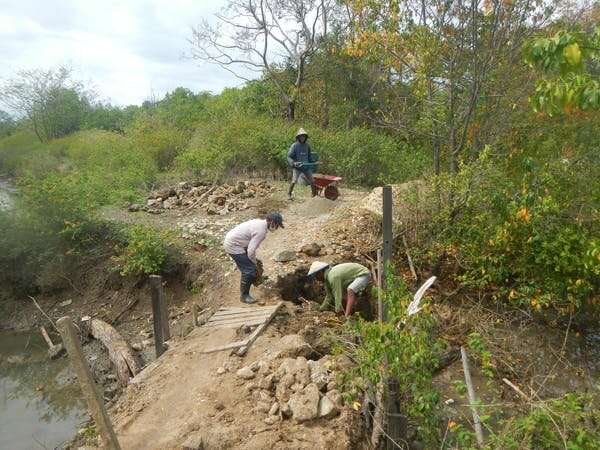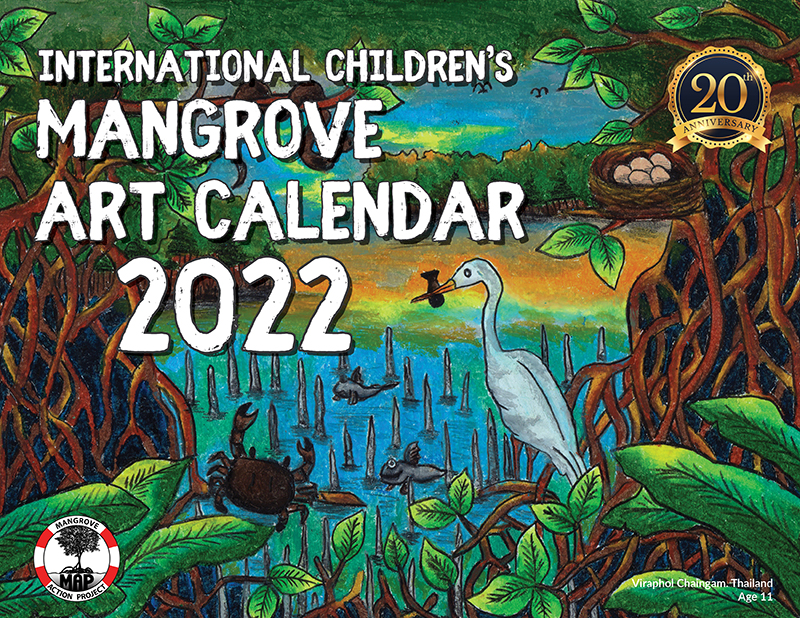MAP Website en Español haga clic aqui FEATURED STORY Co-existing mangrove-coral habitats have a new global classification system

GLOBAL – On any given day between 2016 and 2019, Heather Stewart could be found snorkeling in between mangroves in the Bocas del Toro archipelago along Panama’s Caribbean coast. For years she visited these forests at the interface between land and sea, trying to understand what drove corals to grow inside them. Corals and mangroves often grow near each other in tropical coastal environments, but finding them sharing the same habitat appeared to be an evolutionary trait that deserved an explanation. With this in mind, a group of researchers that included Stewart and other scientists from STRI, the University of Miami, Santa Fe College and the University of Florida set out to create a system to classify coexisting mangrove-coral (CMC) habitats around the world. They reviewed scientific studies and identified the main characteristics and conditions occurring in these ecosystems. “We believe it is important to have a global classification system for coexisting mangrove-coral habitats because for nearly a century these systems have been known to exist, but were largely ignored by the scientific community,” said Stewart. “Now with all the threats corals face from ocean warming and acidification to pollution and sedimentation, corals are becoming more susceptible to diseases. Thus, there is greater interest in potential refugia to aid in the future of coral survival.” READ MORE GLOBAL
NOW OPEN FOR SUBMISSIONS!
Mangrove Photography Awards 2022

USA – The Mangrove Action Project is getting ready to launch the 8th Mangrove Photography Awards to promote mangrove forests in celebration of World Mangrove Day. The contest offers a chance for photographers of all levels to raise their voices for the protection of one of our most critical ecosystems, whilst giving us a fascinating insight into the world of mangroves from all corners of the earth. Through the power of imagery,your photos can reveal the importance and diversity of life in our coastal forests and help inspire action to conserve our mangrove ecosystems. The Mangrove Photography Awards is open to everyone of all ages; all photography enthusiasts and professionals worldwide for a chance to win cash prizes and products donated by our partners Follow us on Instagram and Facebook to keep up to date with the contest and mangrove stories. Please get in touch if you are interested in helping to promote the contest, World Mangrove Day and the importance of our mangroves, through powerful imagery. Contact leo@mangroveactionproject.org
Remote sensing helps track carbon storage in mangroves

GLOBAL – In a recent study in Scientific Reports, researchers from the Institute of Industrial Science, The University of Tokyo, developed a model to assess the productivity of coastal mangroves in China. Mangroves grow along tropical coastlines and are regularly inundated by seawater. These unique species are well adapted to tropical coastal habitats and have special features such as aerial roots and salt-tolerant tissues that enable them to thrive under dynamic conditions. As a result, the productivity of mangrove forests is influenced by a range of environmental factors, such as sea surface temperature, salinity, and photosynthetic active radiation. In the past, light use efficiency models have been used to assess the productivity of terrestrial forests but there are no such models for more complex mangrove ecosystems. “Previous attempts to model mangrove productivity have used field measurements and produced estimates at a local scale,” says lead author of the study, Yuhan Zheng. “But to truly understand the capacity for mangroves to store carbon, global assessments are needed, and these require measurements of environmental conditions on a much larger scale.” READ MORE AMERICAS
World’s biggest bacterium found in Caribbean mangrove swamp  FRENCH ANTILLES – Scientists have discovered the world’s largest bacterium in a Caribbean mangrove swamp. Most bacteria are microscopic, but this one is so big it can be seen with the naked eye. The thin white filament, approximately the size of a human eyelash, is “by far the largest bacterium known to date,” said Jean-Marie Volland, a marine biologist at the Lawrence Berkeley National Laboratory and co-author of a paper announcing the discovery in the journal Science. “It’s an amazing discovery,” said Petra Levin, a microbiologist at Washington University in St Louis, who was not involved in the study. “It opens up the question of how many of these giant bacteria are out there — and reminds us we should never, ever underestimate bacteria.” READ MORE Dig, dump, repeat, then watch the forest grow

Mexico — In Mexico’s Yucatán Peninsula, a few words describe the most common occupations: fisher, merchant, mother. Over the past decade, the port town of Chelem has seen the emergence of a new line of work. Starting in 2010, a group of 18 local women, many of them descended from the Maya, have undertaken the conservation and restoration of their local mangrove forests. They call themselves Las Chelemeras Located 51 kilometers (32 miles) north of the city of Mérida, Chelem borders some 100 hectares (247 acres) of red and black mangrove trees, where crocodiles, crappies and kingfishers abound among a menagerie of native species. In recent decades, however, an outsized push for tourism and urban development has caused the deterioration, and in some cases deforestation, of the surrounding mangrove ecosystem. READ MORE Mangroves need Everglades restoration now more than ever

USA – Sea level rise is outpacing South Florida’s coastal wetlands, according to a new Florida International University (FIU) study. That means the iconic twisted and long-legged roots of South Florida’s mangroves could be drowned by rapidly rising seas by the end of the century. National Oceanic and Atmospheric Administration (NOAA) data shows in the last 20 years, the average rate of sea level rise in South Florida has accelerated faster than previously thought, increasing from 6.5 mm to 9.4 mm a year, compared with the historical rate of 3.9 mm a year. Without mitigation efforts, open water could replace the areas where mangrove forests currently reside. The new projections are a clear sign mangroves are in need of urgent help. But there is also a clear, actionable solution according to the researchers. “Mitigate, mitigate, mitigate,” said Randall Parkinson, a coastal geologist in the FIU Institute of Environment and lead author of the study. “A healthy patient responds better to a virus or other health threat than a sick patient. Our coastal wetlands are sick, and we need to help them get better — like rehydration, removal of topographic barriers — to optimize their chances of survival.” READ MORE Mangrove and reef restoration yield positive returns on investment for flood protection

USA – A new analysis demonstrates that restoration of mangroves and coral reefs can be a cost-effective solution for coastal flood reduction in more than 20 countries across the Caribbean. The study, published May 28 in the journal Ecosystem Services, used methods from the risk and insurance industry to provide rigorous valuations of these natural defenses and show that they can deliver a positive return on investment, with the benefits from reduced flood damage exceeding the costs of restoration. The results point toward new opportunities to support restoration efforts with funds from sources that support hazard mitigation, climate adaptation, and disaster recovery, including the U.S. Federal Emergency Management Agency (FEMA). “We identify a number of funding sources that have traditionally supported artificial ‘gray infrastructure,’ such as concrete sea walls, and that could be applied to nature-based solutions,” said lead author Michael Beck, a research professor in the Institute of Marine Sciences at UC Santa Cruz who holds the AXA Chair in Coastal Resilience. READ MORE Mangrove nursery takes root

ST. THOMAS – In the back of the Marine Biology Center at the University of the Virgin Islands’ Kean Campus, sits rows of large blue tubs filled with green mangrove sprouts. The sprouts are tended to by the GRROE USVI Mangroves research team, and will one day be planted at sites throughout the territory designated for recovery efforts. GRROE stands for the team’s mission, which is to grow research, restoration, outreach and education of the territory’s mangrove ecosystems Allison Holevoet, a second-year grad student at UVI, conducts research in the nursery, and carefully studies the sprouts to ensure their survival. In order to combat mangrove habitat loss the land-based mangrove nursery was constructed in 2021 by a cohort of graduate and undergraduate students led by professor Kistin Wilson Grimes. The project is funded under a five-year, $20 million Ridge to Reef grant awarded to V.I. EPSCOR. Researchers were permitted to go out into the field and collect any mangrove seedlings, known as propagules, that had fallen to the ground. READ MORE WWF Looking to Raise Mangrove Restoration Targets

BELIZE – The World Wildlife Fund (WWF) is looking to embark on an initiative to battle the effects of climate change through mangrove restoration. Belize is home to three species of mangroves, namely the red, black and white. According to the Senior Director of WWF, Nadia Bood, mangroves act as carbon sinks that reduce the acidity in the waters and absorb excess carbon from the atmosphere. She says the WWF and the Government of Belize are looking to raise the targets of restoration and protection of mangroves. “There are science based targets for restoration of mangroves and protection of mangroves and so with our work we are hoping to do the research and build the capacity so that we can then start to replicate restoration of mangroves across Belize’s coastline to help Belize as a country meet those targets,” said Bood. VIEW SOURCE ASIA After decades of loss, the world’s largest mangrove forests are set for a comeback

INDONESIA – Mangroves ring the shores of many of Indonesia’s more than 17,000 islands. But in the most populated areas, the world’s largest mangrove forests have been steadily whittled away, and with them, the ability to store blue carbon. You might think it’s too hard to restore mangroves once they’ve been turned into shrimp farms. Previously, this has been true, with an over-reliance on simply planting more seedlings rather than tackling the harder work of social and economic reliance on former mangrove habitat. In response, Indonesia’s government has mapped around 77,000 hectares of the best restoration candidate areas across 300 villages in Sumatra and Kalimantan (Indonesian Borneo), working in full collaboration with coastal villagers. To create alternatives to aquaculture, Indonesia’s national farmer field school program will expand to include hundreds of coastal villages. READ MORE Ratsada to create mangrove eco-tourism nature trails

THAILAND – Ratsada Mayor Nakarin Yosangrat has gained support to use one tract of 101 rai of natural forest and mangroves and another area covering 10 rai to use together as a protected nature reserve complete with nature trails as an eco-tourism attraction. The support for the ‘Ratsada Green in the City’ project (also called the ‘Ratsada Urban Forest Project’) came at a meeting at the Ratsada Municipality offices yesterday (June 22). At the meeting the project gained the approval of the Phuket Mangrove Forest Resource Management Center, Phuket Rajabhat University and the Department of Marine and Coastal Resources.READ MORE Pangasinan school’s mangrove project makes it among ‘World’s Best’

PHILIPPINES – From just a small project 10 years ago, Bonuan Boquig National High School’s environmental initiative of planting mangroves in Dagupan City, Pangasinan province, has brought the school to the shortlist of the World’s Best School Prizes, awarded by international educational group T4 Education. School principal Renato Santillan recalled that Typhoon “Pepeng” (international name: Parma) in 2009 had left heavy damage on fishponds, rivers, and mangroves in their barangay, after which the high school is named. This prompted them to start a project of growing new trees to help support students and their families, who subsisted on their catch at the mangroves before disaster struck. “Recently, one of our students said the initiative became a huge help because they were able to get oysters that grow at the roots of mangroves. [The oysters were] their food amid the [COVID-19] pandemic,” Santillan said in a recent phone interview. READ MORE LAST WORD Dear Friends,
I hope all is going well with you and your work. I am sending a short survey about the current situation regarding shrimp farming and its effect on mangroves today. I am hoping to gain a more current view of the situation because it seems that much less focus is on problem areas where shrimp farm expansion still plays a significant role in contributing to mangrove loss.
Please see the survey questionnaire we at MAP put together. Your help in responding to these questions would be much appreciated, and please pass this on to others whom you feel might add to our survey. I may attend a major aquaculture conference in Seattle in October and want to have a report I can bring that would highlight where the shrimp industry is still having major adverse effects on mangroves and local communities. This could put due pressure on the industry to clean up its act in those areas particularly.
I hope to hear from you soon!
For the Mangroves,
Alfredo Quarto,
MAP TAKE THE SURVEY
Like this newsletter?
Pease consider donating to MAP to keep it going.
Giving could never be easier  *Articles in this newsletter may mention practices being used and/or show exagerated results being claimed without proof. Stories are presented here in effort to show mangrove related activity around the world and do not necessarily reflect Mangrove Action Project’s views or mangrove restoration best-practices. | ACTION ALERTS Please see the survey questionnaire we at MAP put together to discover where the shrimp industry is still having major adverse effects on mangroves and local communities.
TAKE THE SURVEY Stop the Dredging – 6.7 million cubic meters of sand from the Addu atoll basin will destroy nature, biodiversity and the natural defences and resilience of this UNESCO Biosphere Reserve. SIGN THE PETITION Keep fossil fuels out of Bangladesh for the health and wellbeing of the local communities, the beautiful regional beaches and forests, the Bangladeshi economy, and our shared climate. SIGN PETITION Stop this total madness Stop the biggest heated oil pipeline in the world — right through the heart of Africa!
CLICK HERE Strengthen 60 Women Farmers in El Salvador
DONATE HERE
Like this newsletter? Pease consider donating to MAP to keep it going. Giving could never be easier 
MAP Website en Español
haga clic aqui ARTWORK SUBMISSIONS NOW OPEN FOR NEXT YEAR’S CALENDAR

13 Year old Linda Li “Mangrove Adventure” from Kid Dream Art School

WATCH NOW 
Restoring The Natural Mangrove Forest
Watch movie

Community Based Ecological Mangrove Restoration in Rufiji Delta VIEW VIDEO
Video: Mangroves for the Future
View Here WANT TO GET INVOLVED?
Follow and Join MAP!    
Like this newsletter? Pease consider donating to MAP to keep it going. Giving could never be easier 

Interested in connecting or working with MAP? Check out our opportunities here 
MANGROVE ISSUES Want to learn more about mangroves?
Our short presentation will give you a better understanding of the issues we are working to solve. WATCH PRESENTATION What is CBEMR? Download MAP’s 2 page CBEMR Information Sheet containing links to all MAP’s CBEMR resources – CLICK HERE View MAP’s uploaded Videos at
MAP Video Gallery Question Your Shrimp Consumer/Markets Campaign!
WATCH VIDEO Mangroves: Guidebook to Malaysia – Click Here SHARE MAP’S VISION
CLICK HERE to watch short introductory video. Together we can work “at the roots of the sea”. Our short documentary, Reducing the Risk of Disaster through Nature-Based Solutions : Mangroves 
NASA Study Maps the Roots of Global Mangrove Loss

Marvellous Mangroves Curriculum The Marvellous Mangroves Curriculum begins with a simple philosophy – getting future generations to not only learn about, but understand the importance of mangrove forests. VISIT 
The award-winning Marvellous Mangroves (MM) curriculum educates children on the importance of mangroves and their ecological functions, teaching them about modern challenges and mechanisms for sustainability. VIEW VIDEO Marvellous Mangroves Curriculum in Bangladesh – WATCH VIDEO
MARVELLOUS MANGROVES IN BRAZIL
En Portuges 
Marvellous Mangroves – A Curriculum-Based Teachers Guide.
Like this newsletter? Pease consider donating to MAP to keep it going. Giving could never be easier 
“Question Your Shrimp” Campaign Question Your Shrimp – is it really sustainable? Sign the Petition
Note to Our Readers: We strive to keep active links in our newsletter. However, due to circumstances beyond our control, occasionally links to stories may become broken. If you find a link to a story is not functioning, please cut and paste the headline into your browser search bar. In most cases you should be able to locate the original story.
Not yet a MAP News subscriber?
Click here to subscribe.  *Articles in this newsletter may mention practices being used and/or show exagerated results being claimed without proof. Stories are presented here in effort to show mangrove related activity around the world and do not necessarily reflect Mangrove Action Project’s views or mangrove restoration best-practices. *Articles in this newsletter may mention practices being used and/or show exagerated results being claimed without proof. Stories are presented here in effort to show mangrove related activity around the world and do not necessarily reflect Mangrove Action Project’s views or mangrove restoration best-practices.
|




























